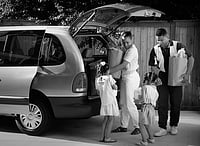Switching Car Insurance Plans in 6 Easy Steps
motor
Many South Africans find their car an essential asset due to the lack of comprehensive public transport in our country. This is why your car needs protection from a slew of ever-present risks.
This makes car insurance a non-negotiable investment. However, our circumstances change over time, and what was once an appropriate level of cover is suddenly not good enough or too much. At Auto & General, we understand this. This is why we've put together this guide on switching car insurance plans in a couple of simple steps. Find out more.
Why would you like to switch car insurance plans?
Despite what you might believe, you can change insurance plans anytime. And you can do this without changing car insurance companies in South Africa. Now, it is unlikely that you would want to switch your insurance plan every year. But there are very good reasons why you might want to switch plans as your circumstances change.
Financial stress can easily lead you to consider cancelling your car insurance, but this isn't the best approach. There are many different types of car insurance to choose from. When finances are tight, a smarter decision would be to downgrade from a comprehensive plan to something like Third Party, Fire and Theft Vehicle insurance. While this doesn't cover damage to your car, it protects you against the cost of damages you cause to a third party's vehicle. And it still covers you against your vehicle being stolen.
On the other hand, positive changes in your financial situation, like a new job or promotion, may allow you to consider upgrading your insurance. Meaning you're covered for a lot more than just accidental damage to someone else's car.
You might also want to consider better coverage when you marry or start a family. While these events usually mean re-evaluating your expenses, they also give you a reason never to be stuck without a car. This isn't something you're guaranteed with a basic car insurance plan.
Other changes usually accompany marriage and children. This could be as simple as an increase in the value of your home contents through home ownership and a need for building insurance. Bundling your car insurance with home contents and/or building insurance can lower your monthly premiums. Retirement or owning an older car are good reasons to consider changing your insurance plan to something less comprehensive.
Finally, one reason would require you to switch plans rather than just consider it: using your personal car for business. Standard car insurance only applies if you use your car for private or personal purposes. You will need business car insurance if you’re using your car for commercial purposes, like attending meetings with a client or delivering goods. Likewise, a side hustle, like transporting packages or food orders or for a ride-sharing service, means switching to a commercial vehicle insurance plan.
Remember, regardless of the reason, you can switch insurance plans anytime. And you can make the switch in six easy steps. Take a look at how easy it is.
How to switch car insurance plans
Our straightforward process lets you switch plans in six easy steps. And you can do this without any penalties or gaps in your cover.
1. Evaluate your current cover
Start by evaluating your current policy. Note the actual cover, monthly premiums, any excess on claims, and any value-added products you have enabled. Then look at the policy terms and conditions and note specific exclusions or clauses applicable to your policy. You want a clear idea of what you currently have before you draw up a list of what you want in your new plan.
2. Research alternative plans
Insurers know that vehicle owners don't all have the same requirements when it comes to insurance. This is why they offer different types of car insurance, such as Third Party Only, Third Party, Fire and Theft, and Comprehensive Car Insurance. Insurers structure each plan with varying levels of cover to satisfy different budgets and degrees of risk aversion. Cover for specific events, like tyre & rim guard insurance, is available as value-added products.
Understanding your current policy coverage and new requirements makes evaluating alternative plans easier. Carefully consider what each plan covers versus your current cover, noting inclusions, exclusions, and the excess on claims. This is an important step regardless of whether you are switching to a higher or lower level of cover.
3. Speak to an insurance broker
Speaking to an insurance broker can be a valuable step before taking any other action affecting your cover. Their in-depth knowledge of the insurance industry and insurance products means they can provide you with professional advice. You can expect their insights to be more objective and pragmatic while fully considering your needs.
Be honest about your current situation, why you want to switch plans, and what you seek in a new plan. Depending on the age of your policy and how significantly your situation has changed, they might do a new risk assessment. Based on this, they could offer you a lower premium. You wouldn't even need to switch plans if money was the issue.
4. Purchase the new policy
Switching car insurance plans means purchasing a new policy. You're staying with the same insurer and already know the plan you want, so you can skip the online quote and call your insurer directly. An agent will guide you through the policy process, confirm details, possibly request some documents again, and then verify your new premium and coverage details. They'll send you the policy to review.
Once you confirm, the new policy should activate immediately. However, it's always wise to verify this for peace of mind. Review your new policy documents carefully, and remember that your new policy comes with a 30-day cooling-off period. So, you can still cancel it if the cover isn't right.
5. Cancel your old policy
There's a good reason for you only cancelling your old policy after the new policy is in place and active. If you cancel it beforehand, you have no insurance cover until you have a new policy. It might only be for a day or two, which doesn't seem too long. But you would have no risk cover or recourse if something happens to your car before your new policy is active.
6. Review your car insurance policy annually
You should now see why it's important to review your insurance regularly. Your needs will always change over time. By reviewing your policy regularly, you can reassess your needs and decide whether your cover is sufficient. Look at what has changed in your life since you last reviewed your insurance. Do you need more cover because your risk profile has changed? Were you a new driver or younger than 25 when you bought the policy? Do you now have other insurance products but haven't bundled them to lower your premiums? If you don't review your insurance policy regularly, you could be over- or underinsured and not know it.
Compare car insurance quotes from Auto & General
Switching car insurance plans doesn't have to be a hassle. Compare your current Auto & General car insurance with our other plans by requesting an online quote or calling us. Our expert agents can guide you through all the steps and answer any questions.








